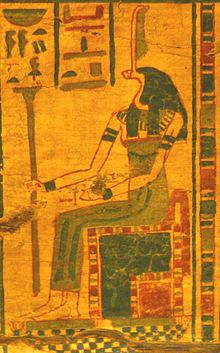return to Home Page
or move on to Goddess Rozanica, next chronologically,
or use Her Cyclopedia Index
Renenet, Snake-of-Nourishment.
R]N]N]T
Alternate meanings: Lady-of-the-Double-Granary.
[to Whom the eighteenth day of October, day 291, is dedicated]

Geography/Culture: Egyptian.
Linguistic Note: Her name consists of two parts: rnn, 'nourishment', and wtt, 'snake'. Perhaps the Greek rho-alpha-nu-iota-sigma, (ranis), 'a drop, rain-drop', is related to Egyptian rnn. It is possible rnn is the origin of the English word rennet?
Description: Goddess of the earth, harvest, nourishment and plenty; She Who is the personification of good fortune; She Who produces the staff of life; Lady of the fertile land; Lady of Aat; She Who protects the newborn; Overseer of child-naming; Divine Nurse; She Who watches over suckling and nurturing and their effect on a child's personality and destiny; She of the inexhaustible breasts; She Whose concern, above all, is for the nourishment of children; She Who is there when the soul is weighed and judged at death.
During the gathering of corn and pressing of grapes people made offerings to Her. As well as depicted suckling the Pharoah, She is sometimes seen suckling the souls of the deceased. Her connection with the dead may be similar to that of Osiris. The double granary (see alternate meaning) may be a reference to the Judgement Hall where the souls of the dead were analogous to grains of corn.
To Whom Sacred: cereals (perhaps especially wheat, barley, dhura, and spelt); cobra (especially the uraeus); human children; rennet (dried extract of the inner lining of the fourth stomach of calves, used in making curdled milk, cheese and junkets); {perhaps} the hekat, a unit of volume used in the measurement of grain; the ren, soul name (which She gives to each child); the eighth month of the Egyptian calendar, Pharmuti, 'the month of Renenet'.
Iconography: Her image was sometimes in the form of a huge snake with horns and solar disk, or with two plumes; or of a Woman possessed of a snake's head. She was sometimes lion-headed. Presentations of Her exist in which She carries the still immature corn god Nepri.
Festival: Her festival took place in April.
Male Associates: Nepri, ----, (variant Nepra), the grain god; he may have been Her son. She is sometimes associated with Shai,----, god of fate (male counterpart, or variant, of Shait).
Titles/Variants, etc:
- Early confused and merged with Ernutet, ----, below.
- A title of Isis, {Lap-of-Power}, as Goddess of the harvest.
- She seems to be sometimes confused with Meshkhent, The-Place-Where-One-Delivers, or is found in association with Her, or She is considered to be one of the four Meshkhents.
- Variant:
Rannut.
- Variant:
Renenutet.
- [Perhaps] variant:
Rennet, a Goddess Who secured the deceased protection if a sceptre-amulet of mother-of-emerald were placed on eris neck.
- [Perhaps] variant:
Rennt.
- Her name is often coupled with that of Shait, She-Shadow.
- The Greeks called Her:
Thermuthis, {Fabulous-Beast}.
Source: Budge BD 172, 193, 236, 305, 623; Funk & Wagnall DFML 932-933; Ions EM 112; Johnson LB 133; Lamy EM 16; Larousse NEM 38; Larousse WM 49; Lurker GSAE 100; Mercatante WWEM 131, 153-4; Walker WEMS 181, 854.
Ernutet, ----
6NWT]T
Geography/Culture: Egyptian.
Linguistic Note: It is possible that Ern(nutet) is a variant of Ren(enet), just as the Derbyshire word 'ern(ing)' is a dialect variant of 'ren(net)', by a shifting of r, for ren.
Description: She Who is the personification of a rich harvest.
It is conjectured She took Her form from the snakes which fled to and were discovered in the last standing corn as it was harvested.
To Whom Sacred: grain; snake (perhaps especially cobra).
Source: Funk & Wagnall DFML 932-933; Ions EM 112.
worked on: October, June 1995; July 1991; June 1990.
Return to the top of this document.
